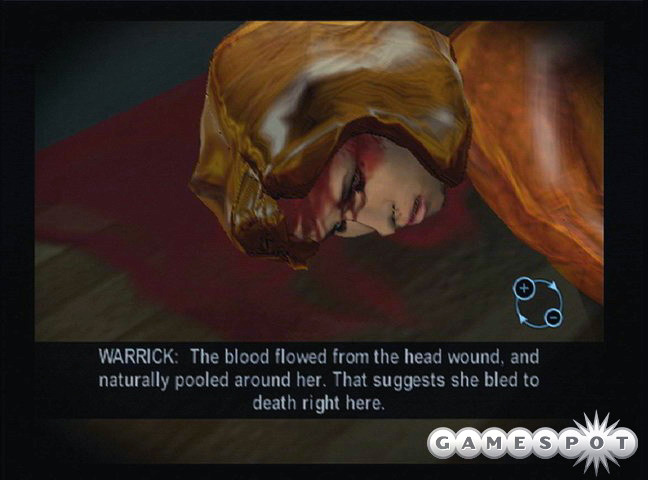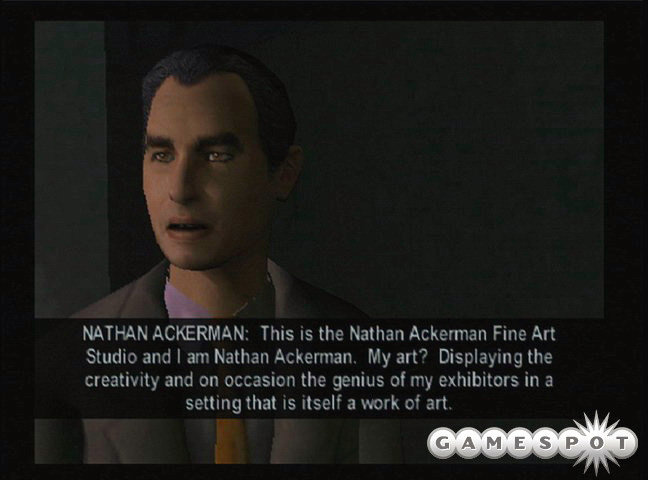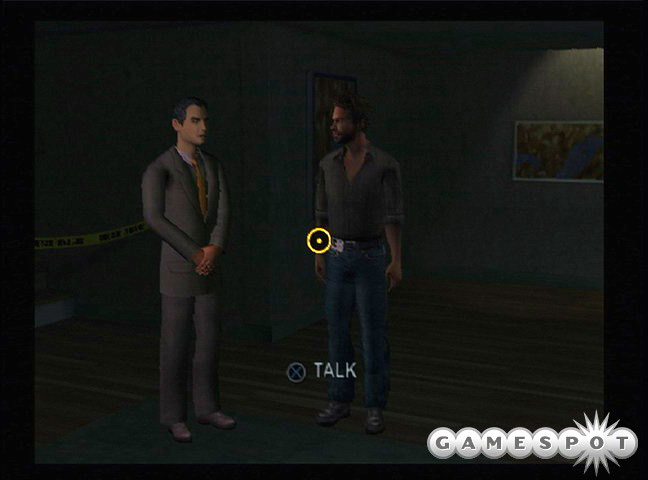CSI: 3 Dimensions of Murder was originally released on the PC nearly a year-and-a-half ago. So why, exactly, are we getting a PlayStation 2 port of it now? This half-hearted, crime-solving adventure game based on the hit TV show didn't offer much more than the same rudimentary take on semen-stain swabbing and footprint photography that the previous CSI games had produced. Not to mention that it had a bad habit of telegraphing the identity of the murderer long before the case was closed. Now it's on the PlayStation 2, and it's every bit the snoozer it was on the PC, only with grainier, darker visuals and a more cumbersome interface.

The premise of 3 Dimensions of Murder will be immediately familiar if you've played any of the previous CSI games. You're a new recruit in the Las Vegas Crime Scene Investigation unit. At the beginning of each case, you're given a crime scene and a cast member from the show to pair up with. They primarily act simply as a mouthpiece, given that you're the one doing all the investigating and evidence collecting. The cases presented in 3 Dimensions of Murder generally revolve around, of all things, murder. You'll find a dead woman on the floor of an art gallery, an apartment drenched in blood (but with no body to be found), and even a gunshot victim found on the floor of a demo booth at the fictional Las Vegas equivalent of E3.
In fact, the best part of 3 Dimensions of Murder is that it does go to some lengths to throw in some inside jokes about the video game industry--primarily in the specific case mentioned above. For example, marketing people talk about how great games that don't sell are failures, and weak games that do sell are winners; there are random digs at the proliferation of sex and violence in games (slightly ironic for an M-rated adventure); and there's even a fictional, canceled game series starring a cartoon duo that's highly reminiscent of Sam & Max.
However, there are two problems with all of this. One, the CSI games aren't targeted at the kind of hardcore players that would even begin to understand what any of these gags mean, and two, that case is the only one with any cleverness behind it. The rest of the cases travel the same roads of murderous intent that have been seen both in the show and in the previous CSI games, and it's not done with much flair or creativity.
If anything, the cases follow a pretty predictable path of logic. Although the evidence is never the same twice, the timeline for suspects is. There are always three suspects in any case, and eventually you'll get warrants to bring them all in. The third one you bring in is always the guilty party. Sometimes the game will loop back around and try to point you in the direction of other suspects, but it always comes back to that third suspect in the end. Before you start screaming about spoilers, the fact is that such a predictable line of storytelling is practically a spoiler in and of itself. Is it some kind of lame tie-in to the fact that it's the third Las Vegas game, and that there's a 3 in the title? Did someone actually think this was clever? Well, it's not, and it's the sort of thing you'll pick up on by the second or third case, whether or not you read this review.
On top of the case predictability, there's simply not too much that's interesting about any of them. The case in the not-E3 trade show is kind of amusing mostly because of the inside jokes, and there is an interesting conclusion to the case involving the blood-soaked apartment, but that's about it. The red herrings the developers try to give you don't do anything to throw you off the obvious conclusions about who did what for which reason. The last case in particular seems like a fairly desperate attempt to try to tie previous cases together into one big, grand finale, but it just feels labored and unnecessary. Plus, it's possible to break the continuity of the story flow from time to time. If you miss an obscure piece of evidence, sometimes the story will continue on, giving you details you won't have the set-up for without that piece of evidence. Once you go back and find that wayward piece of evidence, the set-up for that story bit will then come after you've already heard the next part, which is disjointed to say the least.

Furthermore, the interactions with the characters aren't very engaging. The voice acting is mostly good (at least, from the suspects and other non-CSI types), but there's a lot of it, to the point where characters will sometimes repeat lines and ramble on about nothing of consequence. The cases in this game are certainly longer than the previous CSI games, but not because there's a decidedly higher amount of investigative work to do--they're longer because the suspects just won't shut up.
The investigative work in 3 Dimensions of Murder isn't much different from what you would experience in the other CSI games, with the expecption of the PS2 game's clumsy control scheme, of course. You poke around a crime scene, or a suspect's residence, and look for evidence that points you toward the truth. When you collect evidence, you can swab for blood, dust for fingerprints, run UV lights to look for semen stains, and just rummage around for any trace evidence that might be hidden. At the crime lab, you can do even more: run computer searches for prints, DNA, chemical makeups of unknown substances, ballistics matches, and the like. There's plenty to do, but once you have a basic grasp of how the evidentiary process works, you'll find that there's not much to it. When you pick up a sizable object, always look for stains or fingerprints, and odds are you'll find something. Whenever you find a print, some blood, or anything with DNA, always run it against other samples you have or search through the database. It's basically busywork, although it is somewhat satisfying to watch as the evidence you're collecting paints the picture of what went down.
But again, this is all pretty easy to do and quite predictable in nature. On the default difficulty, it's extremely easy to find evidence, and you can always grab hints from the CSI you're working with if you ever get stuck. Asking for hints docks you on your postcase evaluation, but that evaluation doesn't actually do anything except change the rank you're given at the end of a case. Higher difficulties make it tougher to find stuff, but if you've ever played a crime-solving adventure game before, you'll still know where to look. The main quirk about the game on the PS2 is that sometimes the game just doesn't seem to want to zoom in on evidence no matter how many times you press the X button. Cycling through your locations using the D pad isn't the most enjoyable thing in the world, either.
CSI: 3 Dimensions of Murder was the first in the series to use fully 3D environments and characters, but the shift in graphical style didn't made the game look better in any way, nor did it make the evidence-detecting process any different. You don't freely walk around environments looking for stuff. Rather, there are hot spots and areas you can move to, and you can't go anywhere beyond the limits of those hot spots. The environments look decent enough with the 3D graphics engine, but the character models have taken a decisive step backward. Faces look blurrier and less detailed than they did in previous CSI games, bodies look a little stubby and weird, and the animations of the characters are just as minimal as they were in the old games. On top of those issues, the PS2 version is just drab and dark-looking. It's as if the developers removed practically every light source in the game to get it to run on the PS2, and scaled back all the character and environmental textures to boot. This makes searching for stuff more of a hassle because you'll often have trouble seeing in the near pitch-black of some of the crime scenes.

The presentational issues don't end there--the bulk of the show's cast is on hand for this game, but Marg Helgenberger and Jorja Fox are nowhere to be found. Worse still, the replacement actresses are awful. Both try way, way too hard to emulate the vocal inflections of the two actresses, and they come off sounding pained in the process. William Petersen and Eric Szmanda are the lone bright spots of the regular cast, given that Gary Dourdan and George Eads sound like they couldn't be more bored to be there.
CSI: 3 Dimensions of Murder certainly has its moments, but like every other CSI game to date, those moments are easy to get to, and ultimately unsatisfying because of the light amount of effort it took to arrive. The relative ease of this game, combined with its extremely late arrival on the PS2, the relatively shoddy porting job, and the fact that there's already a sequel to this game out on the PC and Xbox 360, makes 3 Dimensions of Murder feel even more irrelevant than it did upon its initial release. Not that any of the CSI games are wholly recommendable, but 3 Dimensions of Murder on the PS2 is one to especially avoid.